
Logan and Albert Conservation Association

There is a need for a return to regional plans that are understood by the community, have a realistic chance of being implemented and hopefully that the community will hold in high regard.
The focus of the Shaping SEQ seems to be locked in on facilitating urban development through the next fifty years. Despite lip service to other uses the plan does little to ensure that the other uses will be sustained in the face of pressure for urban activity. For example the draft plan notes that “there are a number of areas that have been in the Urban Footprint for some time but have not yet been developed. One way that we could help get things moving is to investigate these areas further, and provide some rules in the state planning regulatory provisions that will allow these areas to be developed sooner“.
The heavily loaded question is then followed with a simplistic “what do you think?”
The SPRP is a legal minefield, especially for non planners but clearly the community can ask that the provisions be improved and made legible. The SPRP usually escapes scrutiny from the community although it is carefully scrutinised (rightly) by the stakeholders reliant of legal provisions especially the land development industry.
If you have additional comments or disagree with the suggestion outlined, it is suggested your own comments be added. But let the Government know that there are problems with the SPRP and how these critical provisions are introduced through the Regional Plan.
To raise the level of community concern about the implementation of ShapingSEQ it is suggested this article be sent either:
Many thanks to the community REDLANDS2030 for their informative articles on the draft SEQRP especially this one used and linked here. http://redlands2030.net/seq-plan-jargon-omissions-bias/
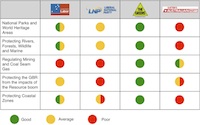 Queensland's environment organisations have compiled and released an election scorecard for the four main parties contesting the Queensland State Election.
Queensland's environment organisations have compiled and released an election scorecard for the four main parties contesting the Queensland State Election.
Whilst the Labor party is assessed as having better policies than the LNP on the protection of the environment, both major parties disappoint on two key matters concerning the State's sustainable future. The Green Party came out on top whilst Bob Katter's Australian Party scored better on mining but failed on most other counts.
Both major parties at this election are failing to meet their obligations on the regulation of mining and coal seam gas. The fate of Queensland hinges on this key issue. How do you run a resource economy without threatening agriculture, groundwater, local communities and essential environments such as the Great Barrier Reef World Heritage Area?
As a response to a GETUP petition, Anna Bligh today has just responded to 3876 emails from Queensland GetUp members, sent yesterday, with a new policy to protect the Bimblebox nature refuge and others like it from mining. In her letter to GetUp members, she wrote: "I can now confirm that Labor's policy would have the effect of ruling out mining in areas like the Bimblebox nature refuge."
What are your values for a sustainable future for Queensland? Make your vote count on election day. Having a say through the democratic election process is an essential part of being a responsible citizen.
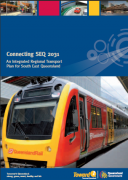 The Queensland Government's Connecting SEQ 2031 transport plan unveils a sustainable transport vision for the next 20 years - according to Transport Minister Annastacia Palaszczuk and Main Roads Minister Craig Wallace.
The Queensland Government's Connecting SEQ 2031 transport plan unveils a sustainable transport vision for the next 20 years - according to Transport Minister Annastacia Palaszczuk and Main Roads Minister Craig Wallace.
This draft document which informed the PARK RIDGE CONNECTOR CORRIDOR Community Stakeholders Reference Group discussions was annouced as policy just before 'whole' community consulation began on the PARK RIDGE CONNECTOR CORRIDOR.
Clearly this proposed new motorway extending south the Gateway Motorway and join the Logan Motorway - both toll roads - the proposed motorway will be a tollroad.
To download a copy of Connecting SEQ 2031, visit the project website at www.connectingseq.qld.gov.au
Connecting SEQ 2031 has established targets for Logan City Council local government area that aim to:
• increase the public transport share of trips from 5.5% in 2006 to 10% in 2031
• increase the share of walking trips from 8.1% in 2006 to 10% in 2031
• increase the share of cycling trips from 0.6% in 2006 to 7% to 2031
• decrease the share of trips by private vehicles from 85.8% to 73%.
Satellite cities and master planned communities can't be just residential developments with a few shops. They need to have fully functioning CBDs, and governments need to commit to providing schools and health facilities years before these cities reach full capacity. They also need to be fully self-sufficient and bring together the very best in business, information and communication technology, education, health, retail and entertainment as well as residential.
Greater Springfield is well on its way to becoming a city of the future which is focused on the integrated master planning principle of living, working, playing and learning in one healthy, sustainable community. Master planned communities need robust public transport, roads, health and education facilities, sewerage, stormwater management and open space systems. But they will also be characterised by the quality, accessibility, reliability and security of their technology platform.
Read the article online in the August edition of the Brisbane Institute.
Raynuha Sinnathamby Deputy Managing Director of Springfield Land Corporation authored this article. Whatever happens there must be alternatives to more roads and more cars. In the areas proposed for development there is currently no public transport and state government has not really been listening. Rail in 2026 is not helpful for current residents and any who come early to the proproposed satellite cities.
On Sunday 29 November, the community forum will be held at the Forest Lake State High School, High Street, Forest Lake.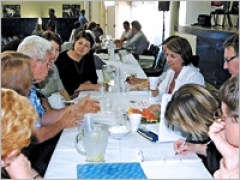
Everyone is welcome to attend.
The program includes informal and formal deputations, where individuals and organisations can discuss issues directly with Ministers, Parliamentary Secretaries and Directors-General. Deputations are limited to 15 minutes.
Sunday community forum program:
1-1.30pm Registration. Information and advice on government services available. Refreshments provided.
1.30- 2.30pm Community forum. Includes a question and answer session.
2.30-3.30pm Informal deputations. No booking is required.
3.30-5pm Formal deputations. A booking is required.
See the Pemier's website for more information http://www.thepremier.qld.gov.au/community/2009/forest_lake_ipswich.aspx
Unfortunately deputation request applications were due 12 noon Wednesday, 18 November 2009. However you lose nothing by trying.
Email This email address is being protected from spambots. You need JavaScript enabled to view it.
Environment, conservation, or environmental sustainability do not appear to have been discussed in past published documents - except for energy matters.
Member for Ipswich - Rachel Nolan MP and Minister for Transport should be present.
The Sustainable Planning Act 2009 (SPA) ( 2.6 MB) was passed by Parliament on 16 September 2009. Queensland government anticipates that the Act will come into effect in late 2009. This Act implements a number of the reform actions in Planning for a Prosperous Queensland - A reform agenda for planning and development in the Smart State ( 970 KB).
Transitioning from the Integrated Planning Act to the Sustainable Planning Act
The transitional provisions have been designed to minimise disruption and to ensure that all processes commenced under the Integrated Planning Act 1997 (IPA) can be completed under the IPA.
Read a short summary of the changes ( 98 KB). This change has been made to reflect a stronger focus on achieving ecological sustainability. The process for asking a local government to apply a superseded planning scheme has been simplified. Also, the timeframe for making an application under a superseded planning scheme has been reduced from 2 years to 1 year. This change is intended to give the new planning instrument, which reflects current planning standards, its full effect more quickly. It also means
that compensation is limited to those persons with an immediate intention to realise their development rights.
The process for making or amending a local planning instrument has been moved from the Act to a statutory guideline. This will enable more flexibility to ensure that planmaking
is continuously improved and reflects current drafting standards.
The Minister's powers to direct local governments to make or amend a local planning instrument have been expanded to enable the Minister:
? to direct a local government to amend a local planning instrument to make it consistent with the standard planning scheme provisions
? to make or amend a local planning instrument where urgent action is necessary to protect or give effect to a state interest, without first giving a direction to the local government
?to amend a local planning instrument, or multiple local planning instruments, to reflect the standard planning scheme provisions without first giving a direction to the local government.
Further information is available at http://www.dip.qld.gov.au/planning-reform/index.php
Integrated Planning Act 1997 (IPA) will be replaced by the Sustainable Planning Act 2009 (SPA).
The government claims it will "Focus on sustainable outcomes"
The new legislation requires a shift away from focusing on planning processes to the delivery of sustainable outcomes - encouraging active community participation in the planning and development assessment system.
It remains for the community to be active in all available processes and ensuring all levels of government hear what it is that the community wants. Development for profit without protecting biodiversity ecosytems and all extant endemic species is not sustainability - ecologically sustainable development must begin NOW!
The South East Queensland Regional Plan 2009-2031 and the associated regulatory provisions were released on Tuesday 28 July 2009. This plan supersedes the previous South East Queensland Regional Plan 2005-2026 and follows an extensive review and consultation process. There is a swarm of articles, media releases etc as a range of groups read and digest the documents.
The plan is available for reading and download from this Department of Infrastructure and Planning website.
If you are concerned about what is planned to happen in SEQ as far as population growth, housing and future developments - whether the iconic and vulnerable koala and its essential habitat is protected, these documents are essential reading.
Watch this space for more information.
Redands and Sunshine Coast councils have posted their submissions to draft SEQRP - Logan will do so soon and the links for all will be posted here. Scenic Rim submission link will be included when available also.
 Courier Mail reported 12 September 2009
Courier Mail reported 12 September 2009
Queensland Co-Ordinator General Colin Jensen has signed off on the Traveston Dam project - with a host of new environmental conditions, including more protection for endangered fish, frogs and turtles in the Mary River.
Work will start at the site near Gympie by early next year if federal Environment Minister Peter Garrett gives his approval. Bruce Highway upgrades will also begin with the work.
But anti-dam campaigners will be angered by the latest developments and are likely to step up their legal action. They have vowed to fight the case to the High Court if it is necessary.
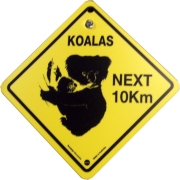 A letter from John Mickel, State Member For Logan,to residents around Chambers Flat Road and Crowson Lane intersection with Mt Lindesay Highway advises us of the status of this major road infrastructure.
A letter from John Mickel, State Member For Logan,to residents around Chambers Flat Road and Crowson Lane intersection with Mt Lindesay Highway advises us of the status of this major road infrastructure.
The letter states
Stage 3 of the Mt Lindesay Highway upgrade will be completed this year.
The service roads linking Granger Road and Stoney Camp Road are already completed as are the roads on either side of Munruben Forest and Munruben Woods. A bikeway on Munruben Forest side of Mt Lindesay Highway is also being completed.
I have approached Main Roads and the local police to ensure uniformity of the speed limit between Chambers Flat and the Maclean bridge. This has been done and the speed limit is now set at 90 kph.
The next phase of safety improvement is being planned for.
I have had discussions with Main Roads for an overpass similar in design to the Granger Road/Stoney Camp Road overpass to be built at Chambers Flat Road and Crowson Lane.
Main Roads are holding a public display on Thursday 2nd July from 5.00pm to 8:30 pm and on Saturday, 4th July from 8.30 am to 12 noon at .the Park Ridge. Shopping Centre, Park Ridge.
Ms Bligh said the reformed government would see 13 new departments lead by the government's 18 Ministers grouped under six clusters - Policy and Fiscal Coordination, Employment and Economic Development, Environment and Sustainable Resource Management, Social Development, Law, Justice and Safety and Government Services.
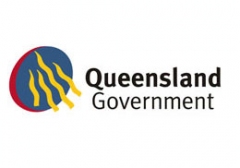 Summary of changes to Queensland government following March 2009 re-electionis available in this document.
Summary of changes to Queensland government following March 2009 re-electionis available in this document.  summary_of_changes_qld_govt_2009.pdf 50.06 Kb 05/04/2009, 22:50
summary_of_changes_qld_govt_2009.pdf 50.06 Kb 05/04/2009, 22:50
The names of ministers and their portfolio/s are summarised in this document from propertyoz.com.au here.  queensland_government_ministry_march_2009.pdf 231.72 Kb 05/04/2009, 22:57
queensland_government_ministry_march_2009.pdf 231.72 Kb 05/04/2009, 22:57
 The current South East Queensland Regional Plan 2009-2031 includes North Maclean as an identified growth area whose future proposed land use or zoning is Enterprise Precinct.
The current South East Queensland Regional Plan 2009-2031 includes North Maclean as an identified growth area whose future proposed land use or zoning is Enterprise Precinct.
In the previous plan the area was labelled an investigation area. The planning language or jargon is misleading as investigation is still required - but the community is still waiting to see background studies for other planning decisions. Without broad community consultation governments have made poor decisions.
People power persuaded the former Beaudesert Shire Council to reverse their hasty decision to suggest an Enterprise Precinct at North Maclean. These scans of council documents record that victory to the local residents.  bsc_mr_3april2007_nmep.pdf 488.29 Kb and
bsc_mr_3april2007_nmep.pdf 488.29 Kb and  bsc_090-080-000005_nmep.pdf 376.48 Kb 22/03/2009, 23:06
bsc_090-080-000005_nmep.pdf 376.48 Kb 22/03/2009, 23:06
Read the letter sent by former Beaudesert Shire Council to the Office of Urban Management and the reply to them. Has this information been conveyed to Logan City Council? Have the potentially affected landowners had an opportunity to discuss their concerns with Logan councillors? Recently acquired copies of this correspondence - after months of asking - are published here in the public domain.
 nmepbsc_to_oum.pdf 338.29 Kb 28/03/2009, 10:01
nmepbsc_to_oum.pdf 338.29 Kb 28/03/2009, 10:01
 nmepoum_to_bsc.pdf 332.11 Kb 28/03/2009, 10:04
nmepoum_to_bsc.pdf 332.11 Kb 28/03/2009, 10:04
A recent meeting with Cr Lynne Clarke is commented upon by Jimboomba Times reporter who also attended the meeting. Read his comments here.  north_maclean_issues_remain.pdf 133.95 Kb 28/03/2009, 13:32
north_maclean_issues_remain.pdf 133.95 Kb 28/03/2009, 13:32
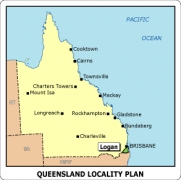 DO YOU KNOW ABOUT THE DEVELOPMENT PLANNED FOR YOUR LOCAL AREA?
DO YOU KNOW ABOUT THE DEVELOPMENT PLANNED FOR YOUR LOCAL AREA?
SEE OUR ADVERTISEMENT HERE  laca_ad_submissions_seqrp.pdf 58.67 Kb 15/03/2009, 22:48
laca_ad_submissions_seqrp.pdf 58.67 Kb 15/03/2009, 22:48
Dear Resident,
In 2004, the South-east Queensland Regional Plan (SEQRP) was released by the State Government to plan development and growth in South-east Queensland. The plan declared the Mt Lindesay North Beaudesert area as an investigation area. In October 2005, a plan considering the development and urban footprint for the Mt Lindesay North Beaudesert area was released to the public for community comments and amendments were made to the 2004 SEQRP . The South-east Queensland Regional Plan is intended to be reviewed every 5 years, and the plan is currently being reviewed (earlier than originally planned) and is now out for another round of community consultation that closes on 3rd April 2009.
In the Mt Lindesay North Beaudesert area, the SEQRP includes large developments proposed for
1. Park Ridge - urban, commercial, industry, enterprise precinct
2. North Maclean - light industry and offices
3. Greenbank - urban with high density living, transit oriented communities
4. Flagstone - urban, plus others
5. Yarrabilba - urban plus others
6. Chambers Flat/Stockleigh/Jimboomba - Southern Infrastructure Corridor (rail/road)
7. Browns Plains/Park Ridge South/Chambers flat/ Stockleigh - Proposed Gateway Motorway Extension
8. Bahrs Scrub - urban growth
The development proposed for the areas 1-8 above are the same as they were 4 years ago .
Submissions / letters expressing your points of concern or support for what is proposed are due by 3 April 2009.
Here is the link for the South East Queensland Regional Plan.
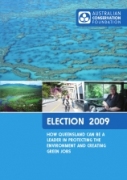 Queensland's economy has been based on many polluting industries taking us on a crash course towards climate catastrophe. Clean and green industries exist such as those based on renewable energy, energy efficiency, sustainable water management, sustainable food production and eco-tourism to name a few. These can deliver new green jobs for Queenslanders. Queensland needs a stronger biodiversity protection framework, a commitment to sustainable water policies and a legislated ban on uranium mining.
Queensland's economy has been based on many polluting industries taking us on a crash course towards climate catastrophe. Clean and green industries exist such as those based on renewable energy, energy efficiency, sustainable water management, sustainable food production and eco-tourism to name a few. These can deliver new green jobs for Queenslanders. Queensland needs a stronger biodiversity protection framework, a commitment to sustainable water policies and a legislated ban on uranium mining.
Queensland's State of the Region Report had little positive to report. Link comming soon.
Australian Conservation Foundation ACF is keeping a close eye the policy announcements of the major parties - but we can all help to put the pressure on over the next weeks until 21 March 2009. Consider taking action now by doing some of the following -
1. Visit ACF website to find out more about the CONSERVATION policies ACF is calling for
2. Write a letter to your local newspaper
3. Call talk back radio
4. Call or visit the office of your local candidates to ask about their commitments to the environment
5. Tell all your friends about the issues
ACF will be publishing a scorecard of the major parties policy commitments to the environment in the week leading up to the election - stay tuned!
The common use of acronyms in planning documents and other professional or specialized areas can be confusing for the new reader to that subject. Shorthening a lengthy expression by saying the first letter of each word is a common occurrence in Australian language. The website acronymnfinder may be useful to help understand. SEQIRTP is here. Those who ride bicycles undoubtedly know what BUGs are.
If you are reading any of the documents attached to the South East Queensland Regional Plan or SEQRP this website may be of assistance if the acronym is not clear from the context of the document. Further links are sometimes included eg TOD or Transit Oriented Development (land development designed to encourage mass transit use) links to an article here.
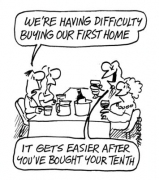 A new survey of 265 housing markets around the world finds Australia has three of the five most unaffordable ones. This includes Sydney at position five, Sunshine Coast and Gold Coast in South East Queensland. Australia's housing price bubble is almost the only one in the world that has not yet burst.
A new survey of 265 housing markets around the world finds Australia has three of the five most unaffordable ones. This includes Sydney at position five, Sunshine Coast and Gold Coast in South East Queensland. Australia's housing price bubble is almost the only one in the world that has not yet burst.
The Demographia International Housing Affordability Survey http://www.demographia.com/dhi.pdf looked at markets in Australia, Canada, Ireland, New Zealand, the United Kingdom and the United States. It compared median house prices with median household incomes to arrive at a ``median multiple''. An affordable multiple is 3. Sydney came up with a whopping 8.3.
Tanberg's cartoon gives one perspective. The topic is the subject of Sydney Morning Herald blog which states that Australia's housing price bubble is almost the only one in the world that has not yet burst. Read it here. Of course this is a complex issue and one on which we will all have our own opinion. Many comments have been written here. Personally I agree with Termite's view
Firstly, in this arid continent, which only has about 7% arable land, we should quarantine good farming sites from housing development. To build on our best and most accessible farmland is short-sighted. We are doing it all over the country.
ABC news disagrees with findings of the survey. Read Housing affordability not as bad as survey claims: analyst which claim is challenged by some in the comments. To me, Dr Shlomo Angel's report seems to be advocating conservative enthusiastic support for urban sprawl.
Housing for humans without destroying habitat for other species is a challenge all Australians face now. As is having enough food to feed us all.
In South East Queensland, the government identified 42 greenfield areas. These areas are distributed equitably across the region, amongst local governments and developers. The areas do not have specific boundaries or addresses. Rather, they are general localities or ‘nodes' where development could occur. As more detailed planning occurs, the boundaries will be refined. The areas are supposed to encroach into the inter-urban breaks of the South East Queensland Regional Plan.
The Department of Infrastructure and Planning DIP has an extensive complex website. Information about greenfield sites begins here and here. The locations are illustrated in the Delivering the Queensland Housing Affordability Strategy - Greenfield land supply in South East Queensland action plan.
Draft regional plan 2009-2031 chapters can be downloaded from here.
The draft South East Queensland (SEQ) Regional Plan and the draft state planning regulatory provisions are open for submissions from December 2008 to 3 April 2009.
For details on how to have your say see detailed advice here.
INQUIRY INTO SMART GROWTH AND TRANSIT ORIENTED DEVELOPMENT TO REDUCE CAR DEPENDENCY IN SEQ was announced on 21 November 2008. Submissions closd 16 January 2009.
![]() The Travelsafe Committee of the 52nd Parliament is inquiring into Smart Growth and Transit Oriented Development to reduce car dependency in South East Queensland. In this inquiry the committee will investigate and report on:
The Travelsafe Committee of the 52nd Parliament is inquiring into Smart Growth and Transit Oriented Development to reduce car dependency in South East Queensland. In this inquiry the committee will investigate and report on:
 The current Queensland government lead by Premier Bligh is proposing a vision for Queensland in 2020 called Towards Q2. Do you share the same vision? What is important to you and your community? This link takes you to the website for Tomorrow's Queensland where you can read what Queenslanders have said already at the several community forums held around the state. Three more forums are planned - last one in SEQ is 3 November at Yeronga in Brisbane. Go online for details to register. Last forum is 5 November - so use the date to be guided for closing date for ideas to have your say.
The current Queensland government lead by Premier Bligh is proposing a vision for Queensland in 2020 called Towards Q2. Do you share the same vision? What is important to you and your community? This link takes you to the website for Tomorrow's Queensland where you can read what Queenslanders have said already at the several community forums held around the state. Three more forums are planned - last one in SEQ is 3 November at Yeronga in Brisbane. Go online for details to register. Last forum is 5 November - so use the date to be guided for closing date for ideas to have your say.
Fill in the online form which guides you to comment on the the 2 targets nominated by the Bligh government team for each area of economy, environment, education, health and communities. OR you can mail directly to the Premier at This email address is being protected from spambots. You need JavaScript enabled to view it..
Where do toxic industries fit in this vision? Not mentioned. Where does farming and food security fit in? Not mentioned. What does 50% more mean for nature conservation and public recreation? Is that measurable? Your input can help to address your concerns. Lets find out if the government hears what we say!
The comments from the Logan forum are available here. All feedback is here.
The SouthEast Queensland Regional Plan Review - 12 months earlier than originally planned is expected beginning December 2008. This will involve more "community consultation" opportunities. Please try to find time to participate in sharing ideas and growing our children's future on our single planet.
Hon Andrew McNamara MP Minister for Sustainability, Climate Change and Innovation says in the foreword:
The policy establishes a framework for using environmental offsets in Queensland. It provides principles and guidelines for applying and developing more detailed ‘specific-issue' offsets policies for important environmental values such as vegetation and fish habitat. Environmental impacts from development must first be avoided and if not avoidable then minimised. Environmental offsets may be used to counterbalance any
remaining loss of environmental values. The policy will ensure that offsets are used consistently and transparently across the State, as a last line of environmental preservation response. The full document can be read here.
In response to expressed community concerns Mr Kevin Lingard, member for Beaudesert raised a QUESTION ON NOTICE Wednesday 30 April 2008 as follows.
Joint Statement:
Premier
The Honourable Anna Bligh
Deputy Premier and Minister for Infrastructure and Planning
The Honourable Paul Lucas
04/06/2008
BLIGH GREENFIELD STUDY REVEALS LAND, LOTS OF LAND
Premier Anna Bligh today announced the State Government would fast-track planning for development of 17 greenfield sites in South-East Queensland, as part of its plan to tackle housing affordability.
Ms Bligh said while the Government was limited in its ability to influence housing prices, she was determined to do everything possible to tackle the issue of affordability.
"I want the Australian dream to be alive and well here in Queensland, particularly for young people wanting to own their first home. Yesterday we announced significant changes to stamp duty to make buying a home in Queensland cheaper and today, we are tackling the issue of land supply. Last year as Treasurer and Infrastructure Minister I commissioned a review of the Greenfield areas within the Urban Footprint that could be market-ready sooner.
"I want to see land being turned into new homes for Queenslanders as quickly as humanly possible and this investigation looked at 42 greenfield areas - containing more than 40,000ha of undeveloped land. As a result - the Government will remove any regulatory hurdles slowing the development process on 12 sites:
• Maroochydore, Meridian Plains, on the Sunshine Coast;
• Market Drive and North Lakes in Moreton Bay;
• Upper Kedron and Rochedale in Brisbane;
• Coomera and Helensvale on the Gold Coast;
• Springfield and Redbank Plains in Ipswich; and
• Kinross Road and South-East Thornlands in Redlands.
"This will make it possible for the industry to begin the development process of these sites by Christmas.
"In addition, there are five sites where we believe integrated communities of 15,000 people or more can be delivered and we will work with councils to prepare land developer-ready within 12 months:
• Palm View and Caloundra South on the Sunshine Coast;
• Flagstone in Logan;
• Oxle y Wedge in Brisbane; and
• Ripley Valley in Ipswich
"That's a total of 17 new Greenfield sites that will be developer-ready by this time next year.
"This is about cutting red tape and bottlenecks that are delaying the development process.
"These bottlenecks are occurring at all levels of government - including within State Government agencies - and its not good enough.
"An implementation team will be established with the Department of Infrastructure and Planning charged with the task of cutting through and removing these hurdles.
"The development industry has been calling on us to make more land in the Urban Footprint available sooner - here it is," she said.
Deputy Premier and Minister for Infrastructure and Planning Paul Lucas said the fast tracking of Greenfield sites will be guided by an Action Plan released today.
"Housing affordability is a challenge that demands action not just at all levels of Governme nt but also from the development industry," said Mr Lucas.
"The industry wants more land released and the Bligh Government has responded with a plan that will provide additional housing choice for the public and contain costs by increasing competition between developers.
"But governments can't do it all alone and we can only bring these sites forward if the necessary infrastructure is in place.
"Yesterday we announced the $107 billion South East Queensland Infrastructure Plan and Program, which demonstrates our commitment to building for Queensland's future.
"Now we need to work with the industry to deliver these sites ahead of time.
"They will also need to demonstrate how they plan to deliver the transport options, road upgrades, water and energy needs for these areas.
"These sites must all be developed as well-planned and integrated communities and the State Government will need to ensure growth is spread across the regions.
"Although the review shows plenty of greenfield land available for housing it must be emphasised the South East Queensland Regional Plan aims to cater for 45 percent of the expected population growth through infill and redevelopment."
"This review is another one of the State Government's strategies to address housing affordability in addition to setting up the Urban Land Development Authority and implementing reforms to the state's planning and development systems."
Queensland Conservation Council's release by Simon Baltais sums up our position also.
Premier ignoring message from last local elections
The Premier's intention to fast track more development - supposedly in the name of housing affordability- is further eroding community trust in her government, according to Queensland Conservation (QCC)
'The planning process is in place, not to stop development but to ensure that development is the right and most appropriate development. Today's decision to fast track development under the misconception it will fix the housing affordability problem is just plain wrong,' said Baltais
Unsustainable population growth is driving the housing affordability problem and yet the state government is encouraging more growth. In doing so they are causing the continued loss of urban bushland, farmland and open spaces to accommodate more roofs and bitumen. Effectively, everyone loses.
If you want to solve the housing affordability issue look towards stabilsation of SEQ growth. What is planned is like throwing fuel onto the fire, it will only make matters worse in SEQ.
‘Community concerns about unsustainable growth, were made loud and clear during the recent local government elections,' said Baltai